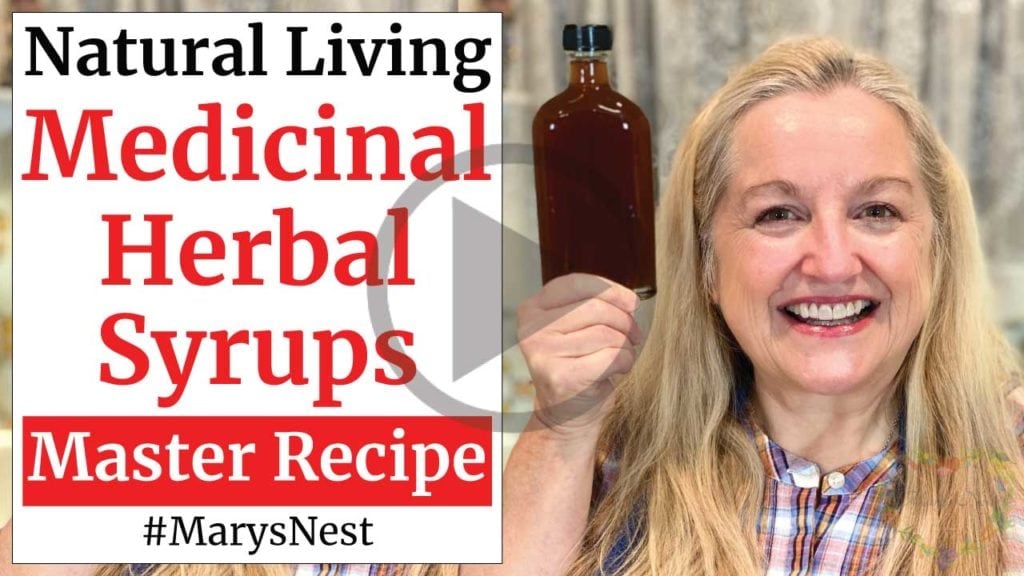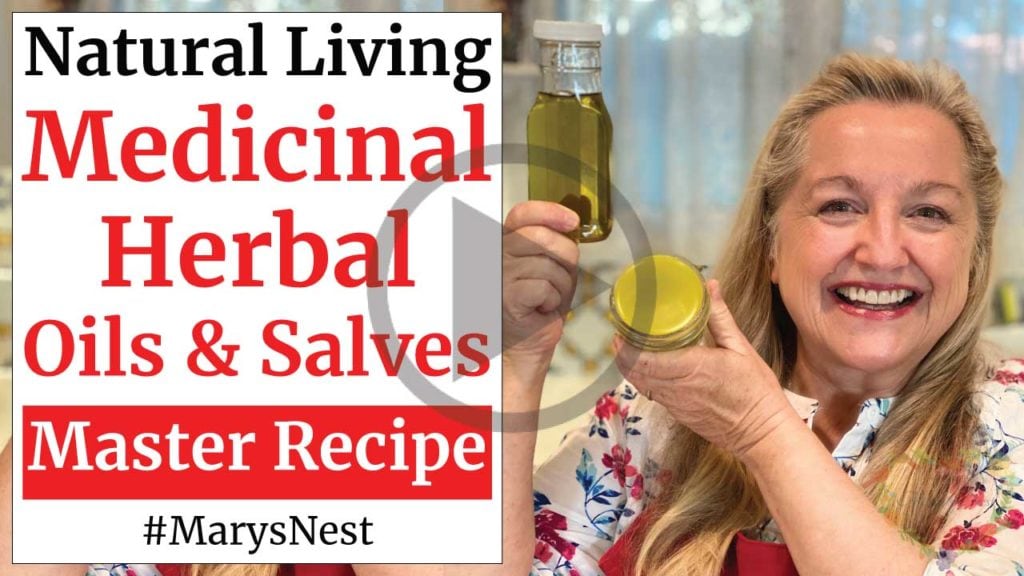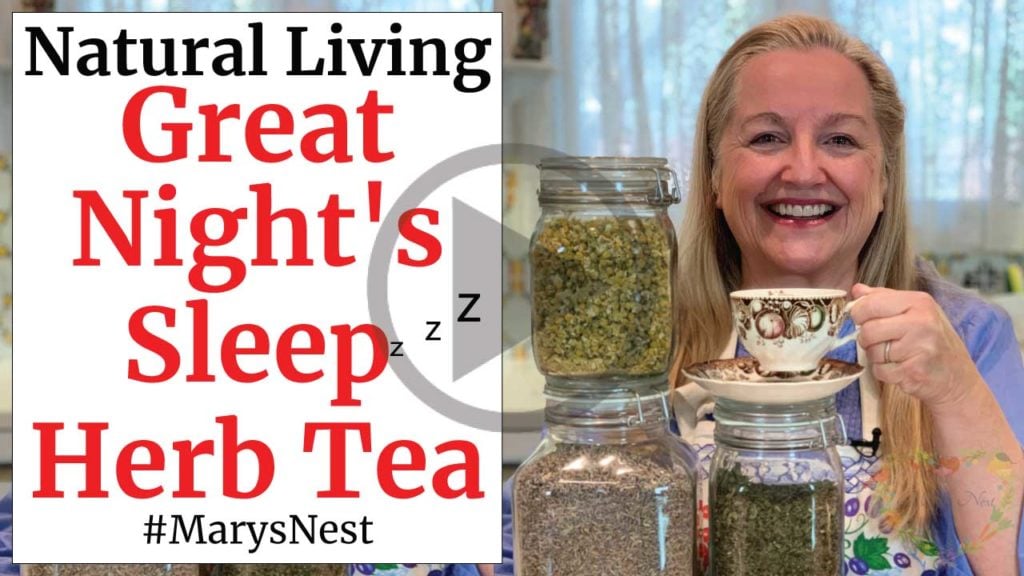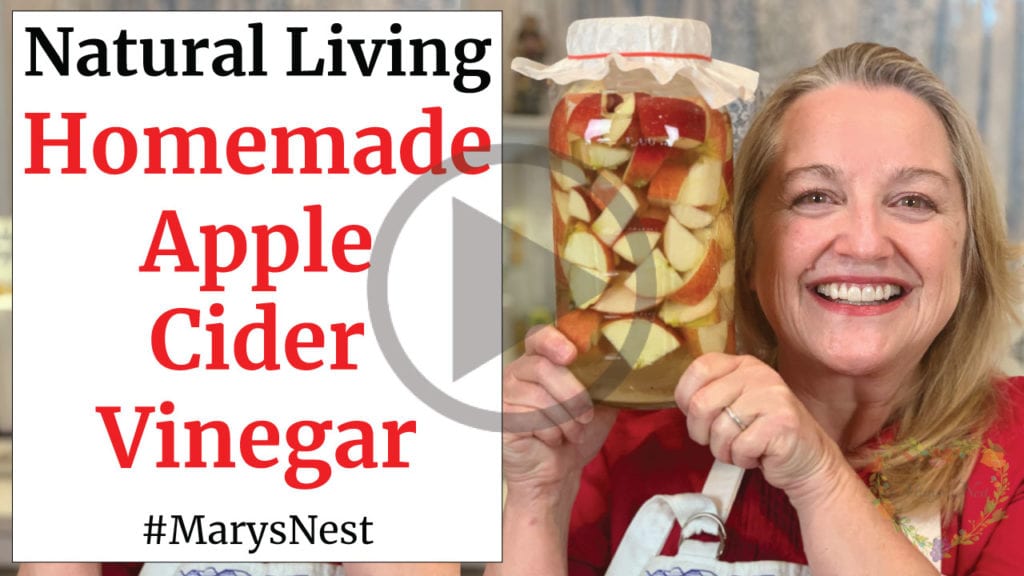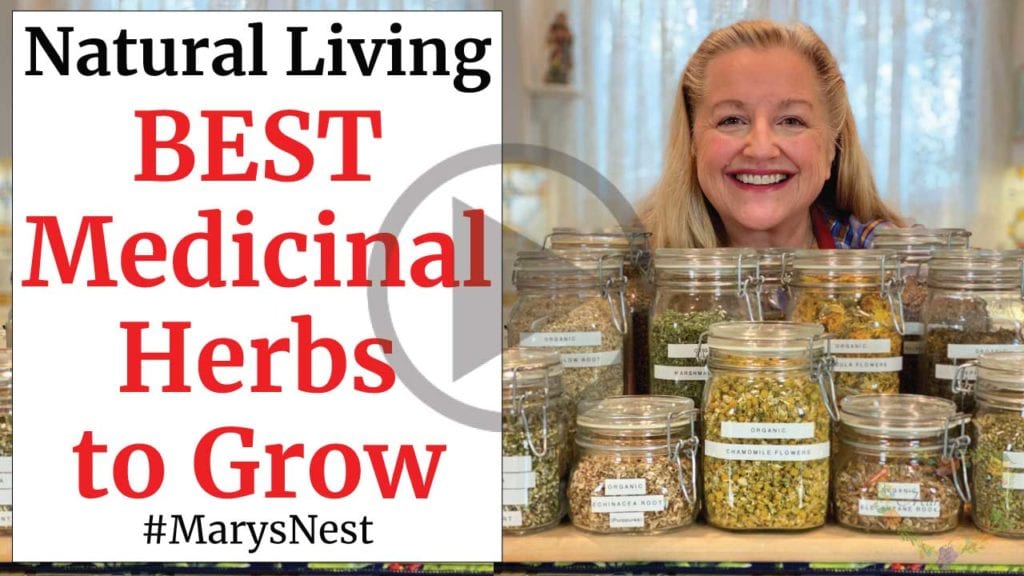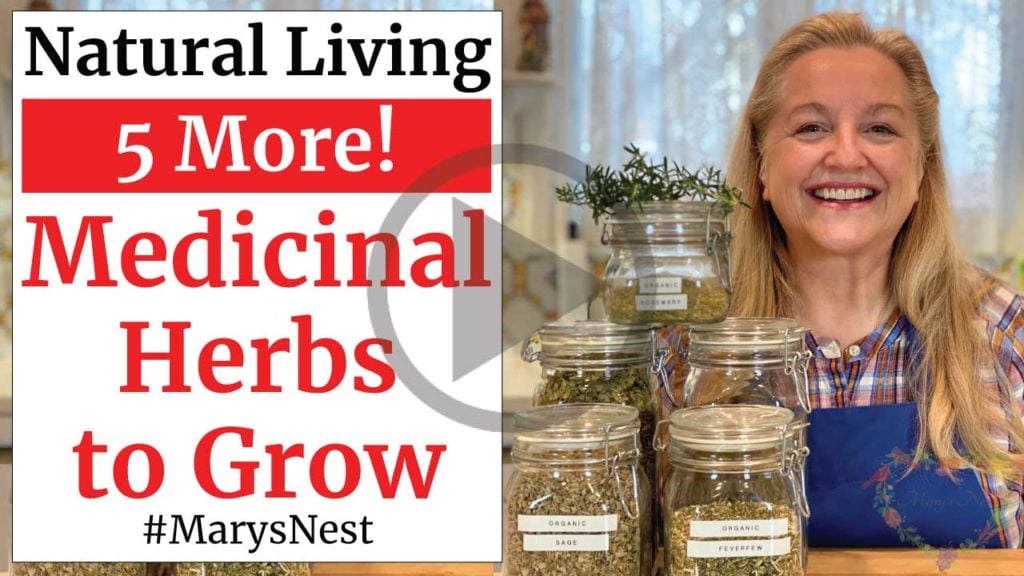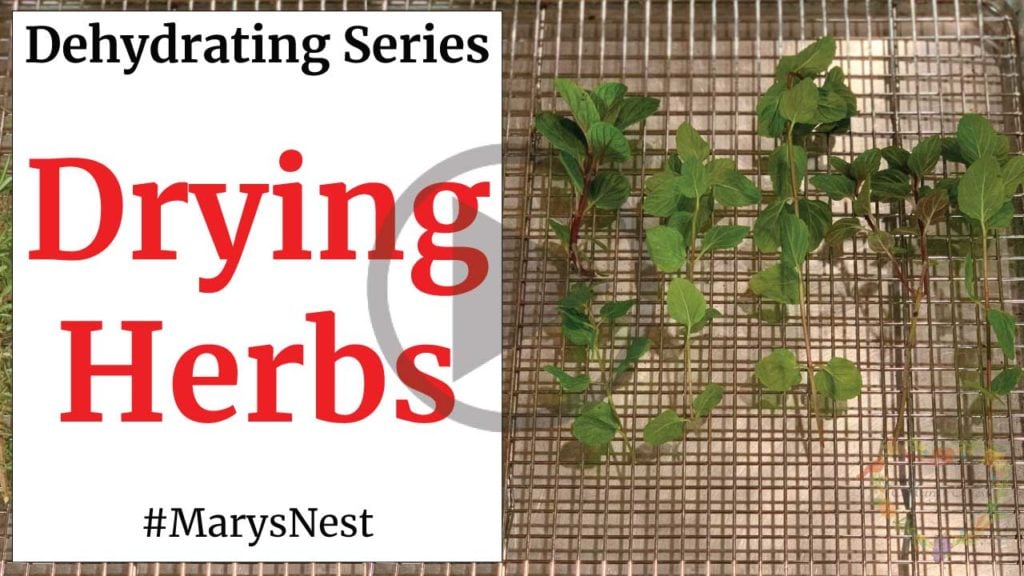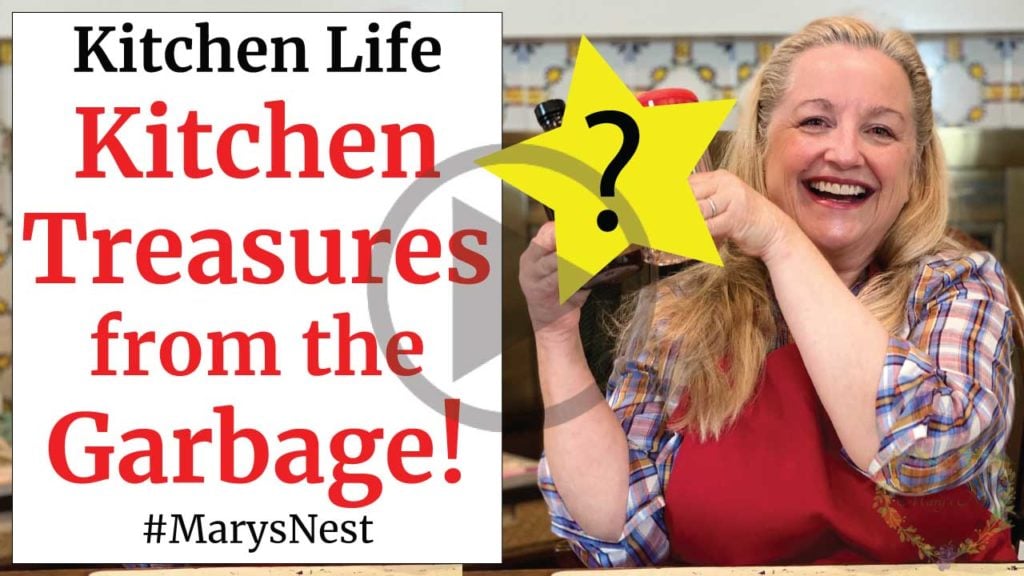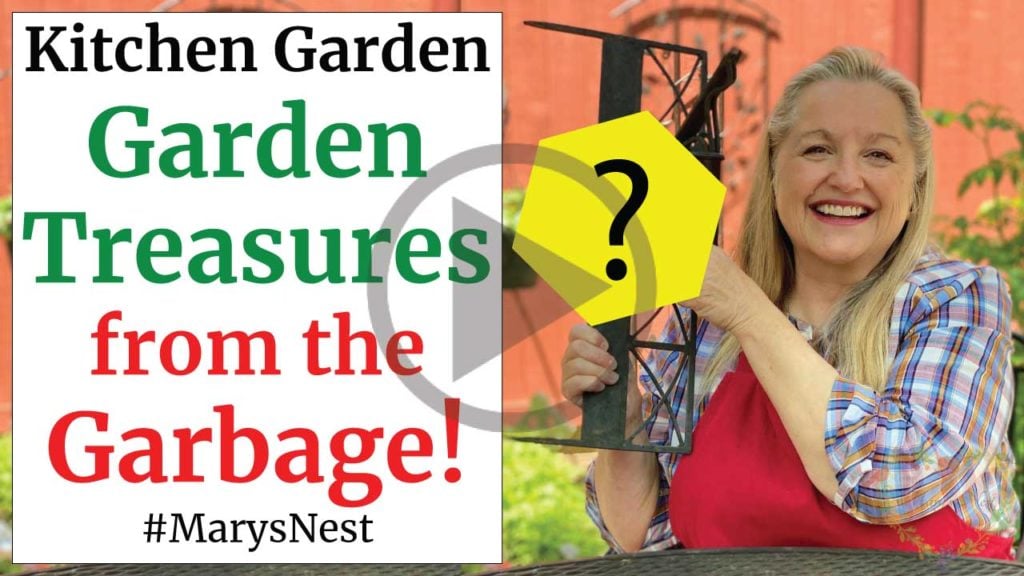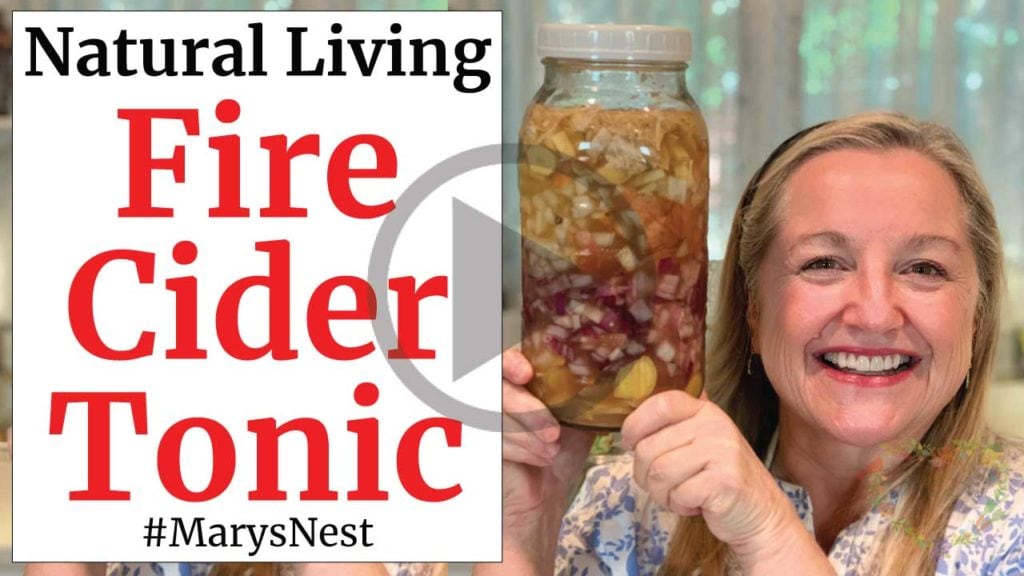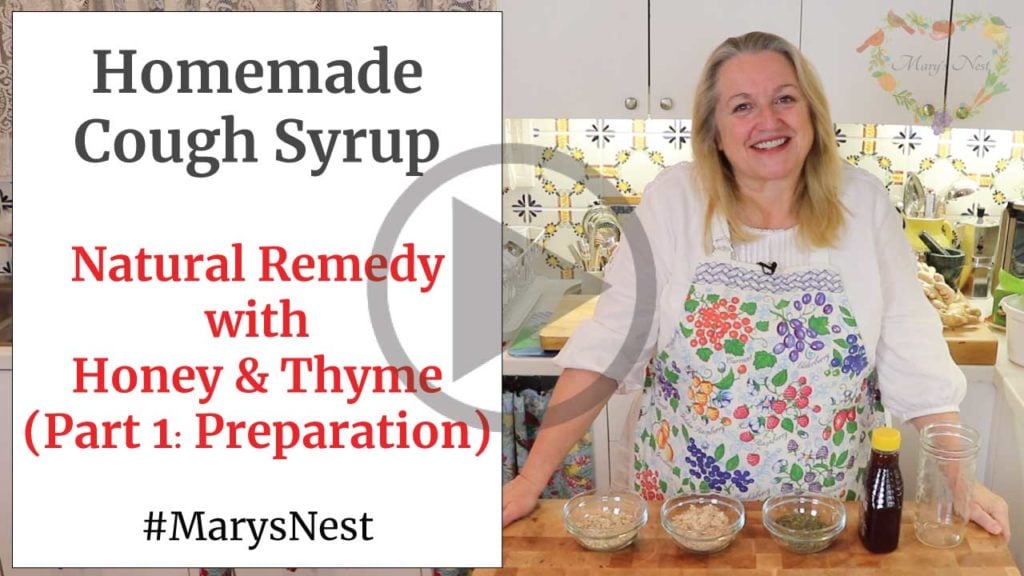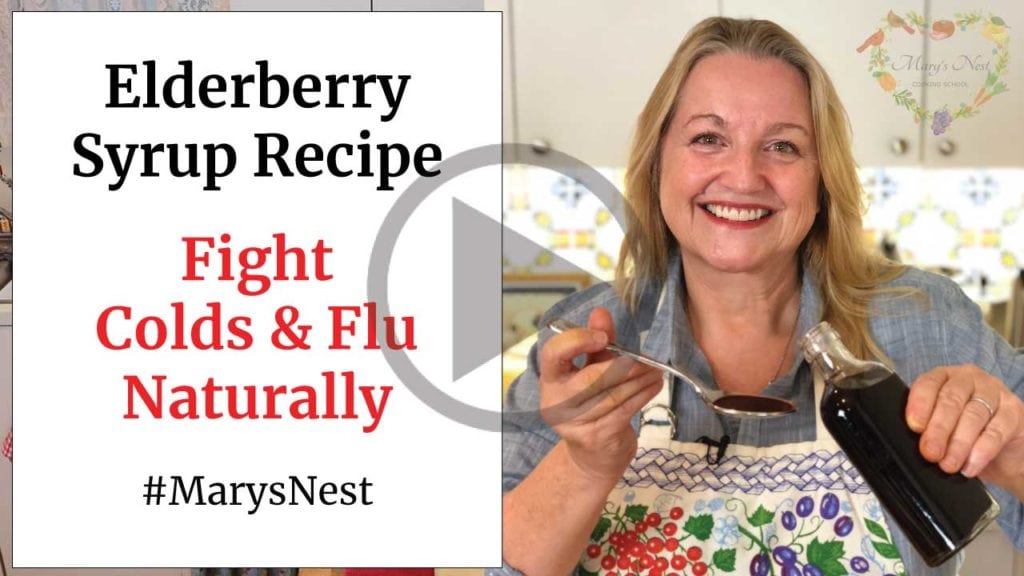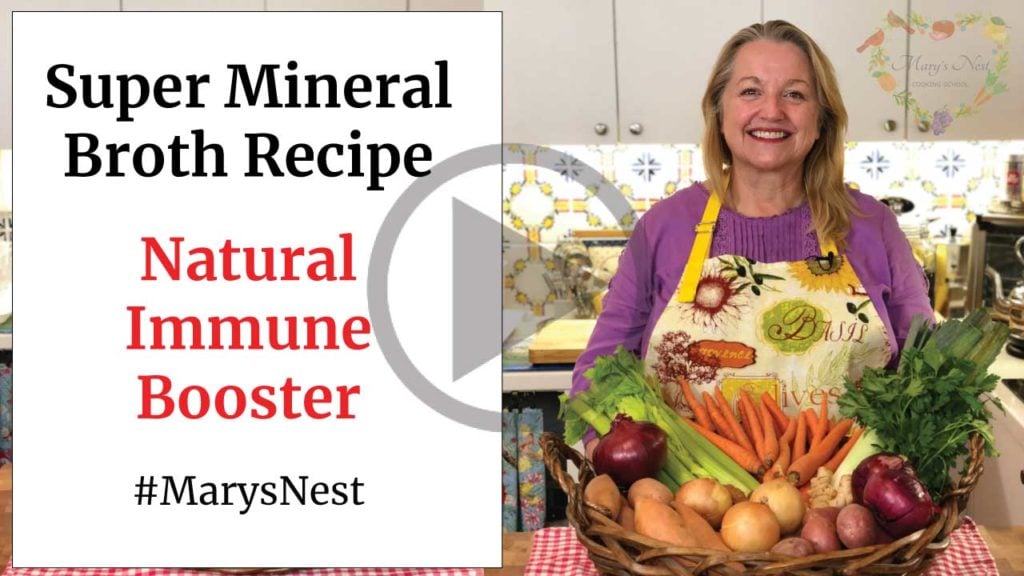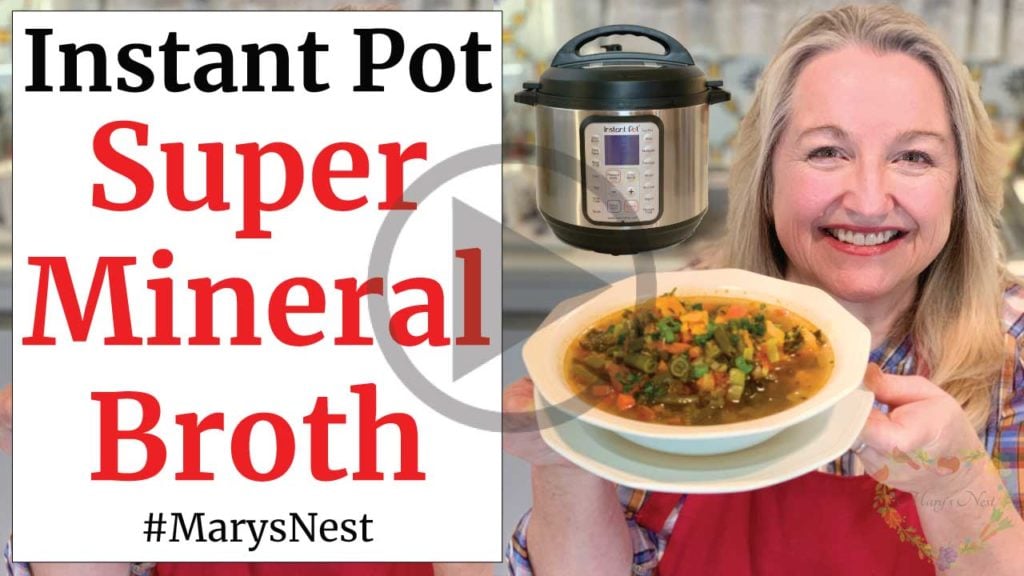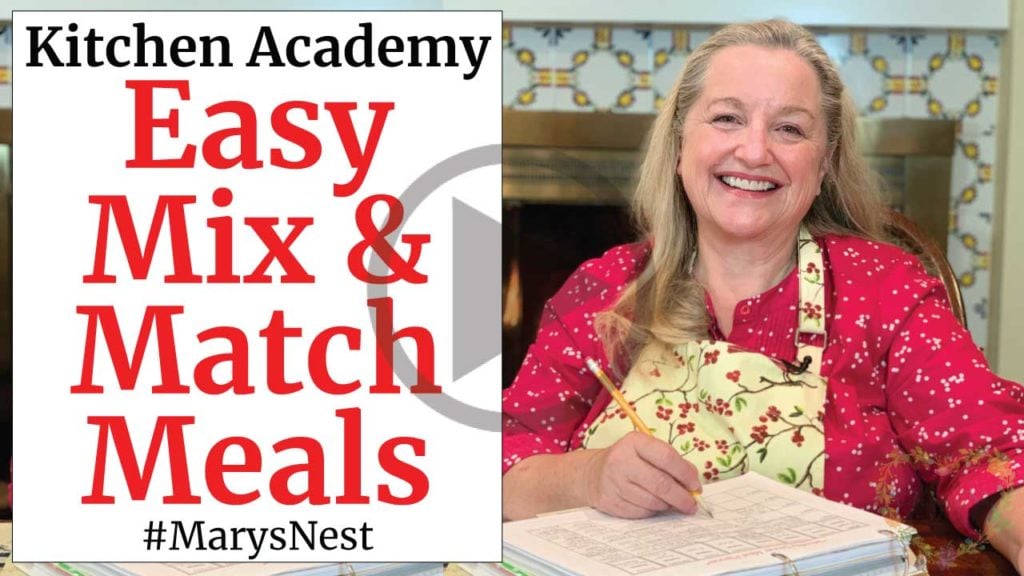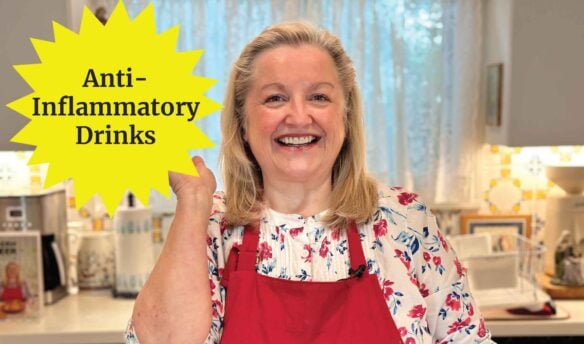Learn this master recipe for how to make medicinal herbal tinctures using any herb with these easy-to-follow instructions. I show you an example of using this master recipe to make a tincture to help with headaches.
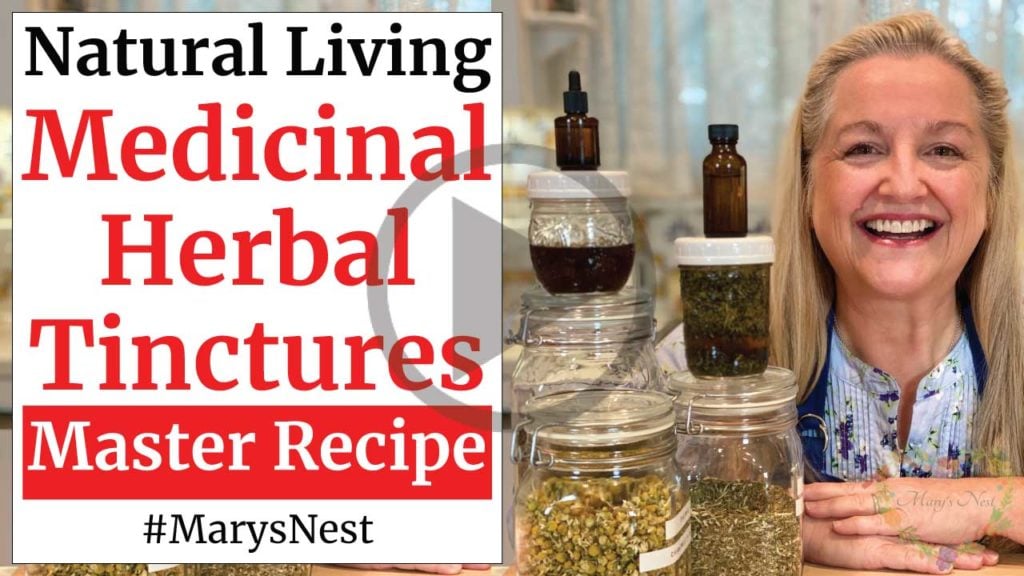
This video is part of my Master Recipes for Making Herbal Remedies Series playlist. (And be sure to consult your medical professional before using any type of medicinal herb.)
Affiliates note: As an Amazon Associate I earn from qualifying purchases. My content may contain affiliate links to products and services. If you click through and make a purchase, I’ll receive a small commission. It does not affect the price you pay.
Table of Contents
- Master Recipe for Medicinal Herbal Tinctures
- Herbal Master Recipes Series
- A Word of Caution as to Medicinal Herbs
- Liquids for Your Medicinal Herbal Tinctures
- Medicinal Tincture Herbs for Headaches
- Grow Medicinal Herbs for Making Home Remedies
- Mountain Rose Herbs
- Treasures from the Garbage
- More Medicinal and Healing Herbal Recipes
- Kitchen Academy Videos
- Medicinal Herbal Tinctures Master Recipe Recipe
Master Recipe for Medicinal Herbal Tinctures
A master recipe provides a recipe template with the basic building blocks you can follow to make something. As with any master recipe, you have the flexibility to customize the ingredients to meet your needs.
For this master recipe, we are making medicinal herbal tinctures, which are concentrated liquid extracts of herbs. Tinctures are a popular form of herbal medicine because, in the words of herbalist Rosemary Gladstar, “They are simple to make, easy to take, and they have a long shelf life.”
Keep in mind that when I use the term herbal tinctures, I am referring to every part of the herb. You can make a tincture using the herb’s leaves, flowers, stems or stalks, and roots. Some parts of the herb are treated differently than others when making a tincture, and I explain the process in detail in my herbal tinctures recipe video. (And in the video, I show you how to use this master recipe to make a tincture to help with headaches.)
Herbal Master Recipes Series
If you have not had a chance to watch my other videos where I share additional master recipes for making making medicinal herbal remedies, be sure to check them out below!
And for an application of the master recipe for making medicinal herb teas, you can watch the following video where I share a recipe for a medicinal herb tea to help you get a great night’s sleep!
A Word of Caution as to Medicinal Herbs
Although we may think of herbs as just ingredients that we add to our pasta sauce, many herbs have potent medicinal properties and have been used as medicine for centuries. With this in mind, you need to approach herbs with knowledge and caution.
If you are pregnant, nursing, taking medication (over the counter or prescription), having allergies, or thinking of using medicinal herbs with children, make sure you first talk to your doctor, pediatrician, or other health care professional. You want to ensure that the herbs you plan to use will not adversely affect you or your children. I can’t stress this enough! Herbs are medicine. Never be casual or negligent in their use.
Now, let’s get started learning about how to make medicinal herbal tinctures.
Liquids for Your Medicinal Herbal Tinctures
You can choose from three liquids to make your medicinal herbal tinctures:
- Vodka (or other alcohol)
- Glycerin
- Apple Cider Vinegar
The liquid you choose will be used to extract the essential or volatile oils from the herbs you are using.
The shelf life defines how long the herbal tinctures will stay fresh and potent, and it varies for each liquid. Vodka (or other alcohol) has the longest shelf life, which is almost indefinite!
Vodka is often the choice of many herbalists when making medicinal herbal tinctures. The reasons are threefold:
- Long shelf life
- Colorless
- Flavorless
Since vodka is colorless and flavorless, using this liquid in your tincture allows the natural color and taste of the herbs to shine through.
For the other liquids, glycerine has a shelf life ranging from 2-3 years. Apple cider vinegar has the shortest shelf life of approximately one year.
To learn how to make your own apple cider vinegar, watch the 3-part series below, where I walk you through the complete 30-day process step-by-step. Learning how to make apple cider vinegar is an excellent skill to help you transition from a processed foods kitchen to a traditional foods kitchen.
Medicinal Tincture Herbs for Headaches
In my detailed video, I show you how to follow this master recipe to make a medicinal tincture to help with headaches. Here are the ingredients that I use:
- Chamomile
- Feverfew
- Peppermint
- Get the amount of herbs used in my master recipe notes.
- Get the herb ingredients from Mountain Rose Herbs.
Grow Medicinal Herbs for Making Home Remedies
To learn how to grow your own herbs to make medicinal herbal remedies, including herbal tinctures, check out the videos below where I share those herbs I consider essential for the kitchen garden. And don’t worry if you don’t have a garden. As I describe in these videos, you can easily grow many of these herbs on a sunny windowsill!
And once you start growing your own herbs, learn how easy it is to dry them. In my dehydrating herbs video, I walk you through the process, and the best part? You don’t need any special equipment!
Mountain Rose Herbs
If you need dried herbs to create a medicinal herb tincture or want seeds to plant medicinal herbs, Mountain Rose Herbs is a high-quality organic resource.
This is not a sponsored blog post. I’m a long-time customer of Mountain Rose Herbs because their products’ quality is far superior to anything else I have ever found. In addition, their website provides helpful information about the herbs they offer, including culinary and medicinal recipes for using herbs.
- Get links to the Mountain Rose Herbs products that I used in this video
- Visit the Mountain Rose Herbs site
Treasures from the Garbage
If you are looking for amber or dark-colored glass bottles to store your medicinal herbal tinctures, look no farther than the garbage…or recycling bin. As I share in my kitchen treasures from the garbage video, people often discard these types of bottles, as well as dark-colored jars. So check with your friends and neighbors to see if they ever throw out these bottle types, and if so, ask them to set these glass containers aside for you. (You can even make them a tincture to say thanks! 😊)
To help out your kitchen garden, watch my kitchen garden treasures from the garbage video where I share treasures to keep an eye out for on trash day!
More Medicinal and Healing Herbal Recipes
Would you like more recipes to learn how to make medicinal and healing herbal recipes? Look no further! Check out the videos below where I share how to make:
- Fire cider tonic
- Homemade cough syrup
- Elderberry syrup
- Plus, a delicious and healing Super Mineral Broth you can make on the stovetop or in the Instant Pot
Kitchen Academy Videos
Are you looking for more traditional foods videos? I invite you to join the Traditional Foods Kitchen Academy. Members of this optional paid YouTube community get access to exclusive videos, live streams, and other members-only perks.
In the following members-only video, I talk about how to Mix and Match for Easy Weeknight Meals.
Stay in Touch with Mary’s Nest
- Subscribe to My YouTube Channel for Traditional Foods Videos (Free) - When you subscribe, be sure to click on the notification bell that will let you know each time I upload a new video.
- Subscribe to Mary’s Traditional Foods Newsletter (Free) - Get a free 36-page eBook for signing up: How to Stock Your Essential Traditional Foods Four-Corners Pantry.
- Join the Traditional Foods Kitchen Academy - For more detailed videos and exclusive members-only perks, join my YouTube membership community.
- Order The Modern Pioneer Cookbook - Get a hardcover book of Mary's nourishing recipes from a Traditional Foods Kitchen. This bestselling cookbook is published by Penguin Random House with their DK imprint.
- Preorder The Modern Pioneer Pantry - Be one of the first to get Mary's hardcover book about preserving food and making delicious meals from your Four Corners Pantry. Mary's second cookbook is also published by Penguin Random House.
I look forward to having you join me in my Texas Hill Country Kitchen!
I’d like to receive more tips and recipes from Mary’s Nest.
Medicinal Herbal Tinctures Master Recipe
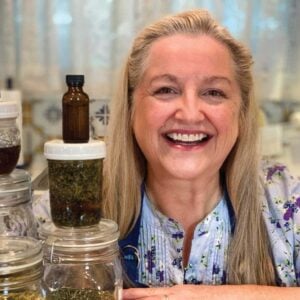
Equipment
- 8 ounce glass jar with lid
- Large measuring cup or bowl
- Amber colored bottle with dropper (optional)
Ingredients
Master Recipe Ingredients for Making a Medicinal Herbal Tincture
- 1/3 – 2/3 cup Edible herbs, fresh or dried If you are using fresh herb flowers and/or leaves, you will need approximately 2/3 cup. If you are using dried herb flowers and/or leaves, you will need approximately 1/2 cup. If you are using herb roots, stems or stalks, and/or berries, you will need approximately 1/3 cup.
- 1/2 – 1 cup Vodka or other alcohol You may also substitute glycerine or apple cider vinegar, preferably raw, but these alternative liquids will affect the shelf life.
Ingredients for Making a Medicinal Herbal Headache Tincture
- 1/2 cup Mixed dried edible herbs including feverfew, chamomile, and peppermint. If you are using fresh herb flowers and/or leaves, you will need approximately 2/3 cup. Whether you are using fresh or dried herbs, you can use equal parts of each of these herbs. For a less strong mint flavor, you can increase the amount of feverfew and chamomile and decrease the amount of peppermint.
- 1/2-1 cup Vodka or other alcohol You may also substitute glycerine or apple cider vinegar, preferably raw, but these alternative liquids will affect the shelf life.
Instructions
Master Recipe Instructions for Making a Medicinal Herbal Tincture
- Fill the 8 ounce jar with the appropriate amount of herbs that you are using. If the herbs are fresh, they are best rough chopped first. If you are using roots, stems or stalks, or berries, they are best well chopped or pulverized first.
- Pour the vodka or other liquid into the jar to within approximately an inch to a half-inch of the rim of the jar. Make sure that all the herbs are well saturated and submerged under the liquid. (See video.)
- Put the lid on the jar and shake it up and down a few times.
- Place the jar in a warm place. You can place it either in or out of direct sunlight. Herbalists assert that the sun will not cause the essential or volatile oils to become rancid because the alcohol acts as a preservative. However, if you are using glycerine or apple cider vinegar, you may want to place the jar in a warm place out of direct sunlight.
- After two days, remove the lid of the jar to check the level of the liquid. The herbs, especially dried herbs, may have absorbed much of the liquid. If so, top off the jar with additional liquid to ensure that the herbs are completely saturated and covered by the liquid. Replace the lid on the jar, shake it up and down a few times, and return it to a warm spot.
- If you want, you can shake the jar daily, but it is not required. However, it is a good idea to periodically shake the jar at least once a week. Doing so ensures that any herbs that may have floated to the top will be re-submerged under the liquid.
- If you are making a medicinal herbal tincture using herb flowers and/or leaves, the tincture will be ready to strain and decant after 4 weeks (28 days). If you are making a medicinal herbal tincture using herb roots, stems or stalks, and/or berries, the tincture will be ready to strain and decant after 6 weeks (42 days).
- To strain the medicinal herbal tincture, place a fine-mesh strainer over a large measuring cup or bowl. Pour the contents of your jar into the mesh strainer and allow the tincture to drain into the vessel below the mesh strainer.
- DO NOT press on the herbs in the mesh strainer. Allow the tincture to drain naturally. You want the tincture to be as clear as possible and free of bits of herbs in it. The spent herbs can be saved for the compost pile.
- Once the tincture liquid no longer drains from the mesh strainer, decant the tincture. The best option for decanting the tincture is into a dark-colored bottle with an eyedroppe,r but you can also store it in any glass bottle that you have.
- Store the tincture in a cool dark place, such as a kitchen pantry or kitchen cabinet. Do not store your herbal medicinal tinctures in the bathroom. The fluctuations in temperature can shorten the shelf life of the tincture.
- The shelf life of an alcohol-based herbal tincture is very long, almost indefinite. The shelf life of a glycerine-based herbal tincture is approximately 2-3 years. The shelf life of an apple cider vinegar-based tincture is approximately 1 year.
- See the Recipe Notes below for additional dosage information.
Instructions for Making a Medicinal Herbal Headache Tincture
- Fill the 8 ounce jar with the appropriate amount of herbs that you are using. If the herbs are fresh, they are best rough chopped first.
- Pour the vodka or other liquid into the jar to within approximately an inch to a half-inch of the rim of the jar. Make sure that all the herbs are well saturated and submerged under the liquid. (See video.)
- Put the lid on the jar and shake it up and down a few times.
- Place the jar in a warm place. You can place it either in or out of direct sunlight. Herbalists assert that the sun will not cause the essential or volatile oils to become rancid because the alcohol acts as a preservative. However, if you are using glycerine or apple cider vinegar, you may want to place the jar in a warm place out of direct sunlight.
- After two days, remove the lid of the jar to check the level of the liquid. The herbs, especially dried herbs, may have absorbed much of the liquid. If so, top off the jar with additional liquid to ensure that the herbs are completely saturated and covered by the liquid. Replace the lid on the jar, shake it up and down a few times, and return it to a warm spot.
- If you want, you can shake the jar daily, but it is not required. However, it is a good idea to periodically shake the jar at least once a week. Doing so ensures that any herbs that may have floated to the top will be re-submerged under the liquid.
- The medicinal herbal headache tincture will be ready to strain and decant after 4 weeks (28 days).
- To strain the tincture, place a fine-mesh strainer over a large measuring cup or bowl. Pour the contents of your jar into the mesh strainer and allow the tincture to drain into the vessel below the mesh strainer.
- DO NOT press on the herbs in the mesh strainer. Allow the tincture to drain naturally. You want the tincture to be as clear as possible and free of bits of herbs in it. The spent herbs can be saved for the compost pile.
- Once the tincture liquid no longer drains from the mesh strainer, decant the tincture. The best option for decanting the tincture is into a dark-colored bottle with an eyedropper, but you can also store it in any glass bottle that you have.
- Store the tincture in a cool dark place, such as a kitchen pantry or kitchen cabinet. Do not store your herbal medicinal tinctures in the bathroom. The fluctuations in temperature can shorten the shelf life of the tincture.
- The shelf life of an alcohol-based herbal tincture is very long, almost indefinite. The shelf life of a glycerine-based herbal tincture is approximately 2-3 years. The shelf life of an apple cider vinegar-based tincture is approximately 1 year.
- See the Recipe Notes below for additional dosage information.
Video
Notes
Shop for items used in this blog post or video
Mountain Rose Herbs Used in My Recipe Video
- Chamomile (Matricaria recutita)
- Feverfew (Tanacetum parthenium)
- Peppermint Leaf (Mentha x piperita)
- More Essential Herbs
Favorite Herbal Supplies
- Hinged Lid Jars
- 8 Ounce Jar
- 8 Ounce Amber Bottle
- 4 Ounce Amber Jar
- Large Measuring Cup
- Mesh Strainers
Favorite Kitchen Supplies
- Favorite Aprons
- Whisk
- Silica Gel Packets (Helps keep moisture from building up in your mix)
- Cast Iron Dutch Oven
- 8-Quart Slow-Cooker
- Fat Separator (Clever kitchen device to help you decant bone broth)
- Flour Sack Towels
- Masontops Fermentation Kit (promo code below)
- Mockmill Grain Grinder and Whole Grains (promo code below)
Use promo code MARYSNST for a one-time 15% off Masontops and Breadsmart products on Amazon.com.
Learn more about Mockmill electric grain mills for making fresh flour and their Flake Lover's Flaker that flakes whole grain in minutes.
Amazon Shop and Shopping Guide
- Visit Mary’s Nest Amazon Shop
- Visit my Shopping Guide page
Get up to 15% off for stocking your Traditional Foods Pantry and equipping your Modern Pioneer Kitchen, including discounts from US Wellness Meats, Farmhouse Teas, Lehman's, Masontops, Cultures for Health, Survival Garden Seeds, Redmond Real Salt, Plan to Eat, and More!
Recommended Reading
Disclaimer:I am not a medical doctor, a medical professional, a dietician, or a nutritionist. All content found on the MarysNest.com website, including text, images, videos, eBooks or eGuides, social media, or other formats, were created solely for informational purposes only. The content is not intended to be a substitute for professional medical advice, diagnosis, or treatment. Always seek the advice of your physician or other qualified healthcare provider with any questions you may have regarding a medical condition or proper nutritional advice. Never disregard professional medical advice or delay in seeking it because of something you have watched in a video or read on this website. Use caution when following the recipe in this video. The creator and publisher of this video and website will not be held responsible for any adverse effects that may arise from the use of this recipe and method or any other recipe and method on this website or corresponding video channel.

